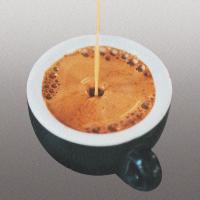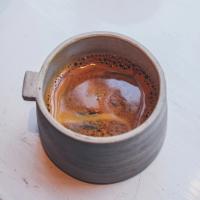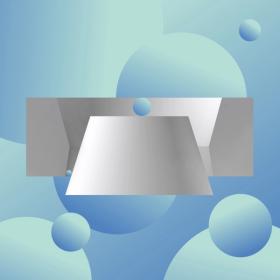What is coffee crema?
Explore the science behind coffee crema, and discover how it forms and what it signifies
Table of contents

How is crema formed?
Crema, which means 'cream' in Italian, is a smooth golden-brown layer of foam that forms on top of espresso coffee. Crema looks delicious and is associated with good coffee — but the reality is more complicated.

Crema is foam made of countless carbon dioxide filled micro-bubbles. Carbon dioxide is a natural byproduct of the coffee roasting process. The reason why it appears as foam — specifically in espresso and not in other brewing methods — is because of the high pressure required in making it.
The more you pressurise water, the better it can dissolve carbon dioxide. This is well demonstrated in bottled sparkling water — when the bottle is opened, the pressure is released and thousands of carbon dioxide bubbles escape.
When pressurised water is forced through coffee, it extracts lots of CO2. Once the brew is in the cup and no longer under pressure, the CO2 is released as tiny bubbles which collect at the surface to create a foamy layer.
Unlike espresso, carbonated water cannot create foam. This is because espresso, like beer and soapy water, contain compounds called surface active agents or surfactants.
Surfactant compounds have two ends, a hydrophilic head which is attracted to water, and a hydrophobic tail which repels water — like tiny water magnets. They disrupts the surface tension of water which increases the formation of bubbles. The positive ends of surfactants then cover these bubbles and reinforce its structure. The negative ends repel other bubbles to stop them from merging, creating a stable foam.
There are many types of surfactants — in coffee are made up of carbohydrates and proteins. The more surfactants and carbon dioxide are extracted from the coffee — the more crema.

What does crema taste like?
Crema tastes bitter and dryer than the rest of the espresso shot. This is due to its CO2 content and lack of sweet compounds — fewer sweet compounds like to adhere to the bubbles.
What you can learn from crema
Freshness - Older coffee creates less crema compared to freshly roasted beans. This is because carbon dioxide stored in coffee escapes over time.
Roast level - Darker roasts contain more carbon dioxide than lighter roasts, so they will create more crema. The colour of the foam can also tell you the roast level of the coffee. Darker roasts will create darker crema, and lighter roasts will create lighter crema.
Level of extraction - If your crema disappears quickly it is likely you have under-extracted your coffee. If there was channeling, the espresso would be less viscous — making the foam weaker.
What crema cannot tell you
Flavour - Crema cannot tell you is if the coffee tastes good. You could over-extract a low quality dark roast and still get a thick rich crema.
Tiger flecking

Tiger mottling or flecking, is a very common effect in espresso, especially in darker roasts, where higher concentrations of coffee particles in the extraction create dotted or stripy patterns in the crema.
These patterns are often very beautiful, and should be no cause for alarm. There is speculation that striping or mottling are signs of channeling and an uneven extraction, but there is little evidence to verify this conclusively.
Stirring and skimming
By and large, crema doesn't taste as nice as the rest of the espresso. For this reason many people like to stir in the crema to even out the drink, and some even skim off the crema altogether.
Crema contains a higher proportion of bitter flavours so if you prefer a more uniform cup, we recommend that you stir the espresso to combine all the layers of the drink.
Spooning out the crema is definitely more effort than stirring, but the results may be to your liking. Removing crema decreases the roasted, astringent and ashy tastes. These tastes aren't necessarily undesirable, as they can make a shot more complex and textured.
Effect of coffee oils on crema
Oils are effective anti-foams, substances which hinder and diminish the formation of bubbles. The more oil there in in your extraction, the less crema you will have, which is why robusta (which has low oil content) can create more crema than arabica.
Oils are less effective anti-foams when they are in smaller droplets. The violent pressure in espresso mixes the oil and water into a such a fine emulsion, that it makes the oils less detrimental to foam.
The higher the pressure, the longer lasting your crema will be.
Colour of crema
The colour of crema directly correlates to the colour of the espresso. They're both made of the same liquid, but the tiny bubbles refract light and brighten the hue.
It's not just the roast level that determines the colour — how the shot was extracted plays a role too.
- The faster the shot, the weaker the colour of your coffee, the lighter the colour of your crema.
- The longer the shot, the stronger the colour of your coffee, the darker the colour of your crema.
Viscosity and drainage
The strength of your coffee correlates with viscosity, which plays a role in the longevity of your crema.
The more extracted your coffee, the more solubles you have managed to dissolve into your water. This increases the viscosity of you drink. Gravity pulls down on the liquid in the bubbles into the espresso, essentially draining the foam.
The more viscous the coffee — the longer lasting the crema.
How to make more crema
Use freshly roasted beans. Freshly roasted beans contains more carbon dioxide than older beans.
Brew your coffee straight after grinding. Coffee loses its gasses very quickly after grinding because of increased surface area. Even a couple minutes can make a huge difference. Agitating the grounds makes the gases escape even faster.
Use darker roasts. Darker roasts will create more crema due to its CO2 content. This will dramatically change the taste of your coffee.
Does crema matter?
When pulling espresso, you should be producing crema. Having no or little crema is an indication that something went wrong in your process, like using too coarse a grind, channeling, or stale beans.
It can tell you a few things, but not the taste. Although crema can indicate many factors like roast level and freshness, you will only know the taste until you drink the espresso.
Stir it in or skim it off. If you don't like the taste or texture of crema, stir it in with a spoon, and if you don't mind the effort, you could skim it off altogether.
Crema looks beautiful. It can influence how we perceive and taste the cup, and it is an essential part of espresso's visual language. It's what makes espresso so alluring, yet part of what makes it so complicated. Crema is a non-negotiable when serving espresso, as most people equate it with good taste and fresh coffee.

Merch
Coffee Tasting Cards for Dialling-in Espresso



